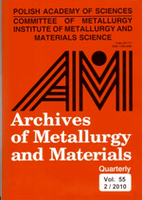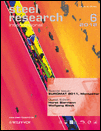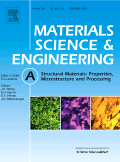
TETSU TO HAGANE-JOURNAL OF THE IRON AND STEEL INSTITUTE OF JAPAN
Scope & Guideline
Pioneering Research in Iron and Steel Innovation
Introduction
Aims and Scopes
- Materials Science and Engineering:
The journal emphasizes studies on the microstructural characteristics and mechanical properties of iron and steel, including phase transformations and deformation behavior under various conditions. - Metallurgical Processes:
Research on various metallurgical processes, such as casting, welding, and heat treatment, is a core focus, providing insights into optimizing these processes for improved material performance. - Corrosion and Environmental Impact:
Papers addressing the corrosion behavior of steel in different environments and the development of corrosion-resistant materials contribute to the journal's relevance in sustainability and environmental impact. - Advanced Characterization Techniques:
The journal promotes the use of advanced characterization methods, such as in-situ observation, neutron diffraction, and machine learning applications, to enhance understanding of material behaviors and properties. - Innovative Applications and Technologies:
Research on the application of novel technologies in steel production and processing, including the integration of data science and artificial intelligence, is a distinctive feature of the journal.
Trending and Emerging
- Hydrogen Embrittlement Research:
With growing concerns over hydrogen's impact on steel integrity, there is an increasing focus on understanding hydrogen embrittlement mechanisms and developing hydrogen-resistant materials. - Data Science and Machine Learning Applications:
The integration of data science and machine learning techniques in metallurgy is trending, with researchers exploring predictive modeling and optimization of steel properties and processes. - Sustainability and Environmental Impact:
Research addressing the environmental aspects of steel production, including recycling, waste management, and the development of eco-friendly materials, is becoming increasingly prominent. - Advanced Characterization Techniques:
Emerging trends include the utilization of advanced characterization methods such as in-situ observations, neutron diffraction, and high-resolution imaging techniques to study material behaviors under real-time conditions. - Smart Manufacturing and Automation:
Studies focusing on the automation of steel production processes and the implementation of smart manufacturing technologies are gaining traction, reflecting the industry's move towards Industry 4.0.
Declining or Waning
- Traditional Metallurgical Processes:
Research centered around conventional metallurgical processes, such as basic casting and simple forging methods, appears to be decreasing as the field shifts towards more advanced and automated techniques. - Basic Alloy Development:
Studies focused solely on the development of new alloys without a significant emphasis on their application or processing innovations are less frequently observed, indicating a shift towards more application-oriented research. - Corrosion Studies in Controlled Environments:
While corrosion is still a relevant topic, studies conducted solely in controlled laboratory environments are declining in favor of research that addresses real-world applications and environmental interactions.
Similar Journals

ARCHIVES OF METALLURGY AND MATERIALS
Championing Open Access to Materials Science InsightsArchives of Metallurgy and Materials is a prestigious open-access journal published by the Polish Academy of Sciences, Institute of Metallurgy and Materials Science. With its ISSN 1733-3490 and E-ISSN 2300-1909, this journal has been a critical resource for researchers and professionals in the field of materials science since its establishment in 2004. The journal focuses primarily on advancements in metals and alloys, contributing to the growing body of knowledge in this dynamic and evolving discipline. As acknowledged in the 2023 Scopus rankings, it currently holds a Q3 category in both Metals and Alloys with a rank of #117 out of 176 journals, indicating its commitment to quality research despite being relatively young in the indexing landscape. With its open-access policy initiated in 2010, the journal aims to enhance the dissemination of scientific findings and encourage collaboration among the global materials science community. Researchers, students, and industry professionals are invited to explore the valuable insights and innovations showcased within Archives of Metallurgy and Materials, contributing to the advancement of material technologies and applications.

Acta Metallurgica Slovaca
Fostering innovation in materials science and metallurgy.Acta Metallurgica Slovaca is a distinguished open-access journal published by SCICELL SRO that has been pivotal in the field of Materials Science and Metallurgy since its inception. With a robust commitment to disseminating high-quality research, this journal covers a wide array of topics within the scope of metals and alloys. Now indexed in Scopus, it ranks 82nd out of 176 in its category, reflecting a growing influence within the scientific community. With a quartile ranking of Q3 as of 2023, Acta Metallurgica Slovaca serves as an essential platform for researchers and professionals seeking to share innovative findings and developments in metallurgical science. Open access since 2013, it ensures that research is accessible to all, fostering collaboration and engagement across academia and industry worldwide. With a converged publication timeline extending from 2009 to 2024, this journal continues to play a crucial role in advancing knowledge and addressing contemporary challenges in the metallurgy sector.

Metals
Shaping the future of materials science through rigorous research.Metals is an esteemed open access journal published by MDPI, focusing on the diverse field of metallurgical science and its applications. Since its inception in 2011, the journal has provided a platform for the dissemination of high-quality research regarding the behavior, processing, and properties of metals and alloys. With an E-ISSN of 2075-4701, it has quickly established itself within the scientific community, achieving a remarkable Q1 ranking in the realm of Metals and Alloys and a Q2 rank in general Materials Science as of 2023. The journal is situated in Switzerland and is committed to the principles of open access, ensuring that findings are accessible to a broad audience without subscription barriers. With its notable impact factor and a strong emphasis on innovative research, Metals serves as an essential resource for researchers, professionals, and students seeking to advance their knowledge and understanding in the ever-evolving landscape of metallurgical studies.

STEEL RESEARCH INTERNATIONAL
Transforming Ideas into Steel Solutions.STEEL RESEARCH INTERNATIONAL, published by WILEY-V C H VERLAG GMBH, is a premier journal that serves as a vital source of knowledge in the fields of condensed matter physics, materials chemistry, and metal and alloy research. With an ISSN of 1611-3683 and an E-ISSN of 1869-344X, this journal provides open access options that enhance its visibility and accessibility. Recognized for its scientific merit, it currently holds a Q2 ranking across multiple categories including Condensed Matter Physics and Materials Chemistry. This translates to an exceptional placement within the 64th percentile for Metals and Alloys and substantial recognition in other related fields according to Scopus rankings. By bridging theoretical concepts and practical applications, STEEL RESEARCH INTERNATIONAL aims to foster innovative research and dissemination of knowledge among researchers, professionals, and students focused on advancing the metallurgy and materials science domains. With a commitment to remain at the forefront of research from 2003 to 2024, the journal is poised to continue shaping the future of steel and alloy studies.

PHYSICS OF METALS AND METALLOGRAPHY
Unveiling the Physics Behind Metal PropertiesPhysics of Metals and Metallography, published by MAIK Nauka/Interperiodica/Springer, is a respected journal dedicated to the study of the physical properties of metals and their metallographic analysis, offering invaluable insights for researchers, professionals, and students in the fields of condensed matter physics and materials chemistry. With an ISSN of 0031-918X and an E-ISSN of 1555-6190, the journal has a rich history that spans from 1970 to 2024, reflecting a long-standing commitment to advancing knowledge in this vital area of materials science. Although it currently does not offer Open Access options, its strong placement in the academic landscape is underscored by its Q3 ranking in both Condensed Matter Physics and Materials Chemistry, according to 2023 metrics, and a Scopus ranking that places it within the competitive percentile of its fields. The journal is particularly important for those engaged in the cutting-edge research and technological applications of metals and alloys, making it an essential resource for anyone looking to deepen their understanding or contribute original findings to this dynamic discipline.

Metallurgical Research & Technology
Advancing metallurgical innovation for a sustainable future.Metallurgical Research & Technology is a distinguished journal published by EDP SCIENCES S A based in France, focusing on the dynamic field of metallurgical science and engineering. With a strong emphasis on the latest advancements in Materials Chemistry, Computational Mechanics, and Mechanics of Materials, this journal aims to provide a platform for researchers to share innovative findings that propel the field forward. As of 2023, it has secured a commendable position in various categories, including Q3 rankings in Computational Mechanics, Materials Chemistry, and Mechanics of Materials, along with a Q2 ranking in Metals and Alloys. The journal actively promotes open access, facilitating broader dissemination of critical research across the globe. Researchers, professionals, and students in the metallurgical domain will find Metallurgical Research & Technology an invaluable resource for cutting-edge developments and collaborative opportunities.

MATERIALS SCIENCE AND ENGINEERING A-STRUCTURAL MATERIALS PROPERTIES MICROSTRUCTURE AND PROCESSING
Exploring Innovations in Structural MaterialsMATERIALS SCIENCE AND ENGINEERING A-STRUCTURAL MATERIALS PROPERTIES MICROSTRUCTURE AND PROCESSING, published by ELSEVIER SCIENCE SA, is a highly regarded journal specializing in the fundamental and applied aspects of materials science. Since its inception in 1988, this journal has established itself as a leading platform for disseminating innovative research findings, particularly focused on structural materials, their properties, microstructure, and processing techniques. With a prominent impact in the field, it ranks in the Q1 category across several disciplines including Condensed Matter Physics, Materials Science, Mechanical Engineering, and Nanoscience and Nanotechnology, highlighting its significance and influence within the academic community. The journal is accessible to a global audience of researchers, professionals, and students, underscoring its commitment to advancing knowledge in materials engineering. Aspiring authors and readers will find this journal an essential resource for cutting-edge research and the latest advancements in the field, further supported by its impressive Scopus rankings that place it among the top-tier publications.

International Journal of Minerals Metallurgy and Materials
Exploring the Frontiers of Metallurgy and MaterialsThe International Journal of Minerals Metallurgy and Materials, published by SPRINGER, stands as a prominent forum in the fields of minerals, metallurgy, and materials science. With an ISSN of 1674-4799 and an E-ISSN of 1869-103X, this journal has been disseminating high-quality research since its inception in 2009 and will continue to publish until 2024. Based in China, this journal supports Open Access options, maximizing the reach and impact of scholarly work. Enhanced by its impressive Scopus rankings, it holds a Q2 position in Geochemistry and Petrology and a Q1 ranking in Materials Chemistry, Mechanical Engineering, Mechanics of Materials, and Metals and Alloys for 2023. Such accolades reflect its continual commitment to advancing knowledge in these disciplines, making it essential reading for researchers, professionals, and students aiming to stay abreast of contemporary developments and innovative solutions in materials science.

Metallography Microstructure and Analysis
Exploring the Depths of Metallic MicrostructuresWelcome to Metallography Microstructure and Analysis, a prominent journal dedicated to the exploration of microstructural properties and their implications in metallic materials. Published by SpringerNature, this journal stands at the forefront of research in the field of materials science, particularly focusing on metals and alloys. With an impressive Q2 ranking in 2023 within its category and a Scopus rank of #72 out of 176, it continues to provide significant contributions to the understanding of metallography, attracting diverse readership among researchers, industry professionals, and students alike. The journal spans a converged period from 2012 to 2024, ensuring it captures the evolving landscape of metallurgical studies. Although it does not currently offer open access, this platform is essential for disseminating high-quality, peer-reviewed research that fosters innovation and development in metallurgical practices.

JOURNAL OF IRON AND STEEL RESEARCH INTERNATIONAL
Uncovering Breakthroughs in Metals and AlloysJOURNAL OF IRON AND STEEL RESEARCH INTERNATIONAL, published by Springer, stands as a leading peer-reviewed journal in the fields of Materials Chemistry, Mechanics of Materials, and Metals and Alloys. With a strong focus on interdisciplinary research, the journal contributes significantly to the advancement of knowledge in these sectors, reflected in its impressive ranking, including Q1 status in Metals and Alloys for 2023. The journal is not only a crucial resource for critical insights into the properties and applications of iron and steel but also serves as a vibrant platform for researchers and professionals to disseminate novel findings ranging from fundamental science to practical engineering applications. With a broad scope that has evolved since its inception in 1996 and maintains a consistent commitment to high-quality research, this journal is essential for students, scholars, and industry experts aiming to keep abreast of the latest developments and innovations in the iron and steel domain.